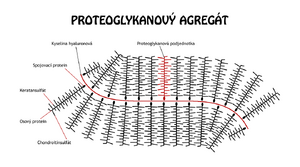Mucopolysaccharides
From WikiLectures
They are also called "glycosaminoglycans" (GAGs). They include e.g.
- Hyaluronic acid
- Chondroitin sulfate (CS)
- Keratan sulfate I and II (KS I and KS II)
- Heparan sulfate (HS)
- Heparin
- Dermatan sulfate (DS)
- They are formed by alternating hexosamine with uronic acid
- Exception: keratan sulfate, which contains galactose instead of uronic acid
- Uronic acids contain carboxyl groups and can also be sulfated (acidic character)
- They have numerous functions in the organism, especially structural ones as part of the extracellular matrix
- They are bound to the protein skeleton (axis protein) by an O-glycosidic or N-glycosidic bond
- Axial proteins bind to hyaluronic acid with the help of a connecting protein to form proteoglycan aggregates
- The amount of carbohydrates in proteoglycans can be up to 95%
- Degradation takes place partly extracellularly, shorter fragments bind to connective cell receptors, are pinocytosed and degraded by lysosomal'endoglycosidases (sulfatase, hyaluronidase) and exoglycosidases ' (β-glucuronidase, xylosidase, iduronidase, galactosidase, N-acetylglucosaminidase)
Links[edit | edit source]
Related Articles[edit | edit source]
External links[edit | edit source]
References[edit | edit source]
- MURRAY, Robert K. – GRANNER, Daryl K. – MAYES, Peter A., et al. Harper's Biochemistry. 4. edition. Jinočany : H & H, 2002. 872 pp. ISBN 80-7319-013-3.

